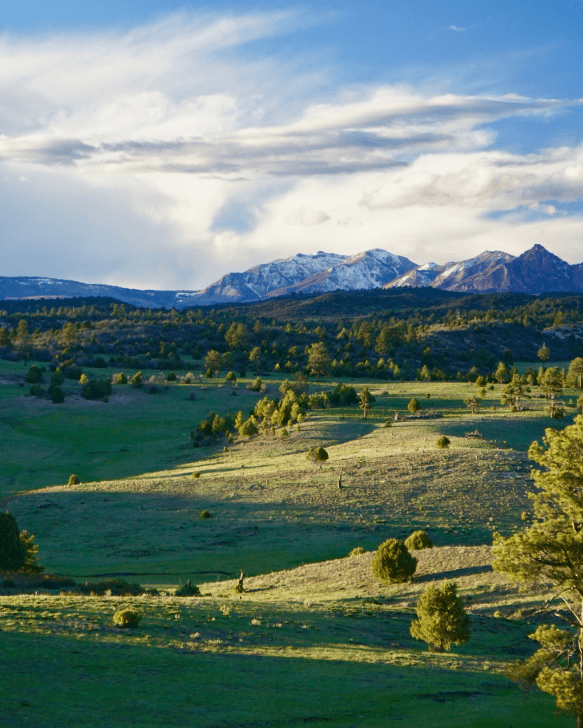To run a successful Colorado cattle ranch, you’ll need to get up to speed on the cattle industry. But to turn a profit, you’ll need determination, applied business skills, and strong intuition and common sense. Your role will be to continuously simplify and improve operations.
If you are new to cattle ranching, be sure you have what it takes. If you’ve run a herd and have experience as a cowhand, you will need to get a grasp on the business aspects. Business acumen will be vital. So, let’s try to get you going.
What to Simplify and Improve to Build Profits
Take cues from the experienced ranchers while you study modern practices. In Beef Magazine, Career Rancher Burke Teichert shares his secrets. Burke says the most important factors for financial gain include ranch size, cows per worker, acres per cow, fed-feed versus grazed-feed, low debt-to-equity ratio, reducing overhead, and improving gross margin. See below for more discussion about each of these elements.
Searching for Colorado Cattle Ranches
If you decide to run a cattle operation, Harrigan Land Company will give you an idea of the most common cattle ranches found in Colorado. They may be on high ground of the Rockies or in the High Plains.
- Turnkey, fully improved and profitable cattle ranches may be available.
- Livestock facilities on available large Colorado properties may need remodeling and the systems updated.
- Vacant Colorado ranchlands or ranches with estate homes. The last two categories of cattle ranches may require construction, but new owners have the advantage of being able to build to suit. They may incorporate modern cattle ranching tools.
- Any of the large ranches—including hunting and recreational ranches, fishing properties, or livestock ranches—may also feature cattle operations.
These multi-use ranches usually diversify to increase profitability. If done right, adding cattle operations can improve the profits.
General Skill Sets Needed for Profitable Cattle Operations
Successful cattle ranching operations start with strong business foundations. Far beyond the actors dressed up on a Western movie set, skilled businessmen stand behind all profitable cattle operations. To develop financial stability, operation managers analyze complex financial data and develop strategic long-term plans.
Top ranch managers often hire help but need to oversee overall productivity. Their oversight is broad. They oversee healthy cattle production as well as grazing land, sales, and much more. They have ability to assess all kinds of elements. In addition, they find themselves approximating for unknown factors.
All of this happens while they strive to project long-term causes and effects. Enter weather conditions, temperatures, rain and snow, and the surprise record levels. Yes, it takes a bit of genius to conquer this outdoor job.
7 Essentials for Financial Gain on Cattle Ranches
When it comes to looking at your profit and loss statement, you don’t want to be spinning your wheels. You want your cattle ranch to be worth the hard work you and the staff put into it. So, please do not let your ranch eat up your money. Make your cattle ranch into a money-making venture.
Find out why Burke says the following 7 elements are essential.
Ranch size
Outside of the largest ranching operations, most ranchers need to supplement their income. Sometimes this means diversifying an existing cattle ranch. For example, you may choose to grow, harvest, or grind corn or hay to lower feed costs.
You may choose to add cash crops or diversify the agriculture to harvest and trade. However, you may be inclined to add vacation rentals, events, hunting, fishing, or other recreation on your land.
Cows per worker
Maximizing the number of cows per worker helps reduce wages and other costs such as housing, equipment, and horses. Growing cattle ranches need to find a balance between workers and cows. Find out the number of cows each employee can handle?
Acres per cow
Work smart and strive to invest in efficient operations instead of buying more acreage, which adds expense.
Fed-feed versus grazed-feed
Although grass fed beef is becoming more popular, the combination of grazing and feed turns out to be easier on the wallet. Unless you have a niche in the grass fed market, know that growing hay for pastureland can help renew your grounds and lower costs. A neighbor network may give the opportunity for cattle to graze more often. Check the manure to find out if your cows are getting the proper nutrition. If not add supplements.
Low debt-to-equity ratio
Try to run in the black so that you have the flexibility to adapt to new circumstances. Only use debt to fund growth and improvement. Even then, be wise. Remember rising interest rates can do you in.
Reducing overhead
Land and labor are costly. The land requires fencing, water troughs, repairs, taxes, and maybe leases. Labor involves salaries and benefits, and more vehicles and as your ranch activities grow. Cut extra maintenance-hungry equipment when possible.
Here are sample ways to cut costs. Lease equipment used seasonally instead of buying it. Buy used equipment if it is easy to keep in good shape. Develop a co-op with neighbor farmers and ranchers or a cattle marketing alliance. Reduce grazing costs by sharing with other farmers who raise corn and sunflower. Maximize grazing by keeping the cattle in smaller portions of land; this will reduce undesirable plants.
In addition, consider reducing waste by investing in quality cattle. Money spent on a quality bowl with good genes and accelerated growth rates can reduce your input and labor. Three cows with good temperament, breed history, and historic pregnancies. Quality can save money.
Improving gross margin
Now let’s talk about sales. Work to improve product prices and like market trends, such as the grass fed beef market currently popular. A healthy profit can be realized by boosting productivity to accommodate changing circumstances.
Conclusion
To make cattle ranches in Colorado produce profits, ranchers become experts in their specific environments and the agricultural opportunities. To achieve financial gain, they consistently analyze complex elements to create specific long-term goals.
In addition, successful cattle ranchers measure progress and continually look for areas to improve the bottom line. Keep detailed records of costs and yields so that you can adjust the approach and strategy. Are you ready for the task yet? Plan to hunt down experts on any of the 7 essential areas to learn more.
Real Estate Agents – Colorado Cattle Ranches
To talk with us about buying or selling cattle ranches for sale in Colorado, call Harrigan Land Company at 303-908-1101. Serving Colorado, New Mexico, Wyoming, Utah, Montana, and the surrounding areas.


